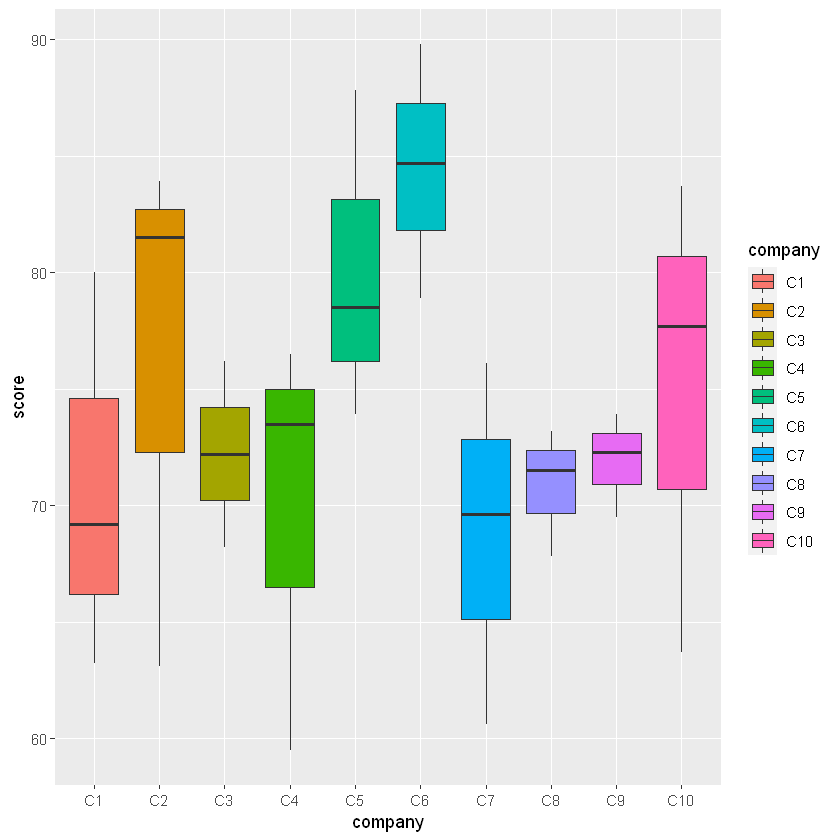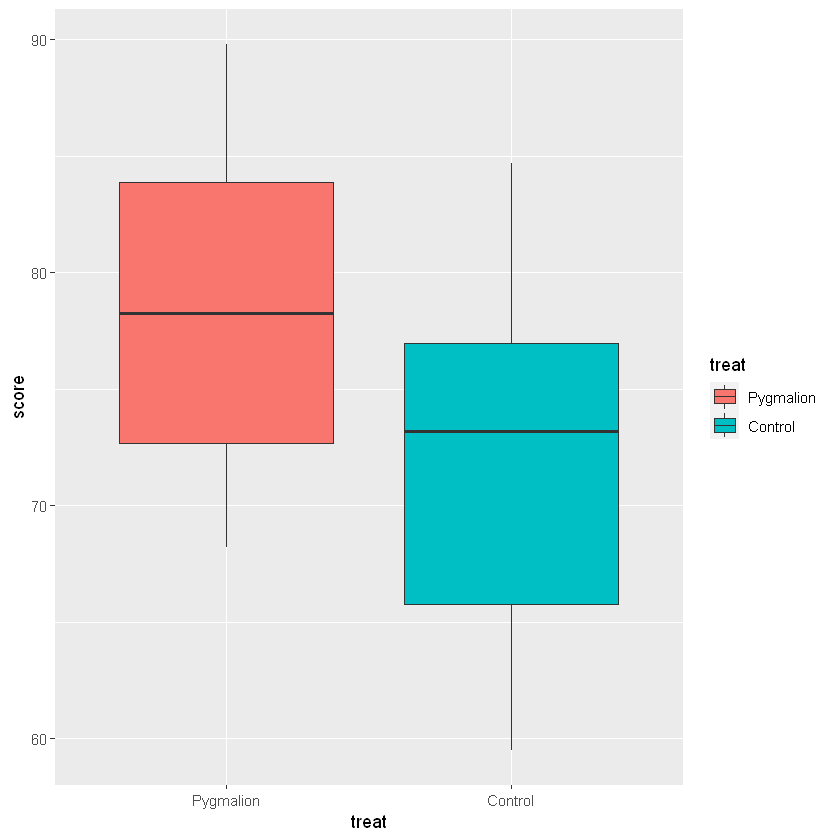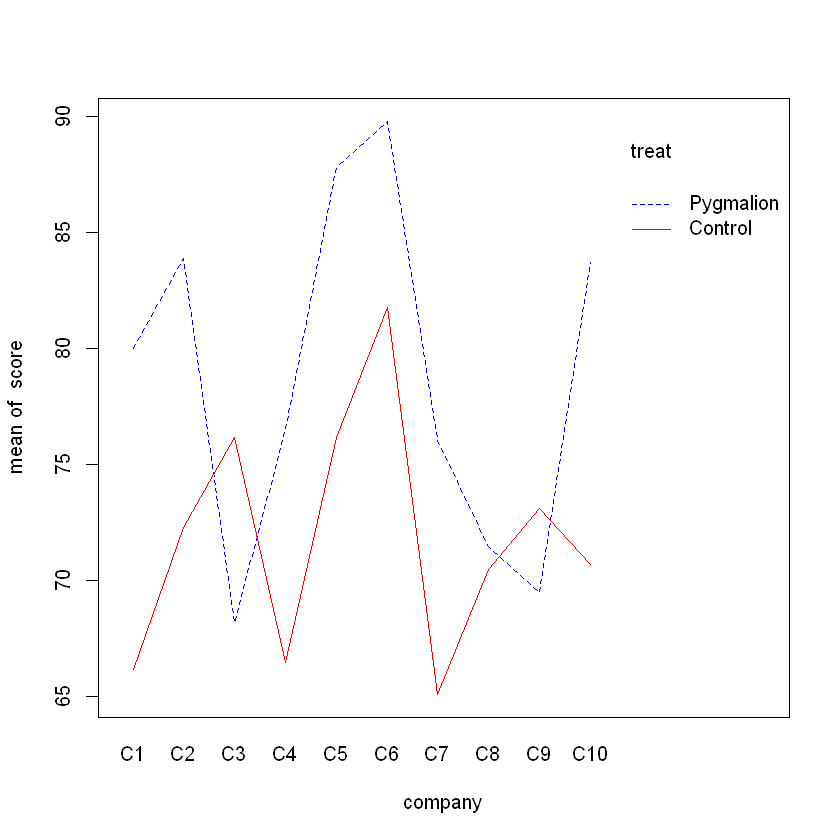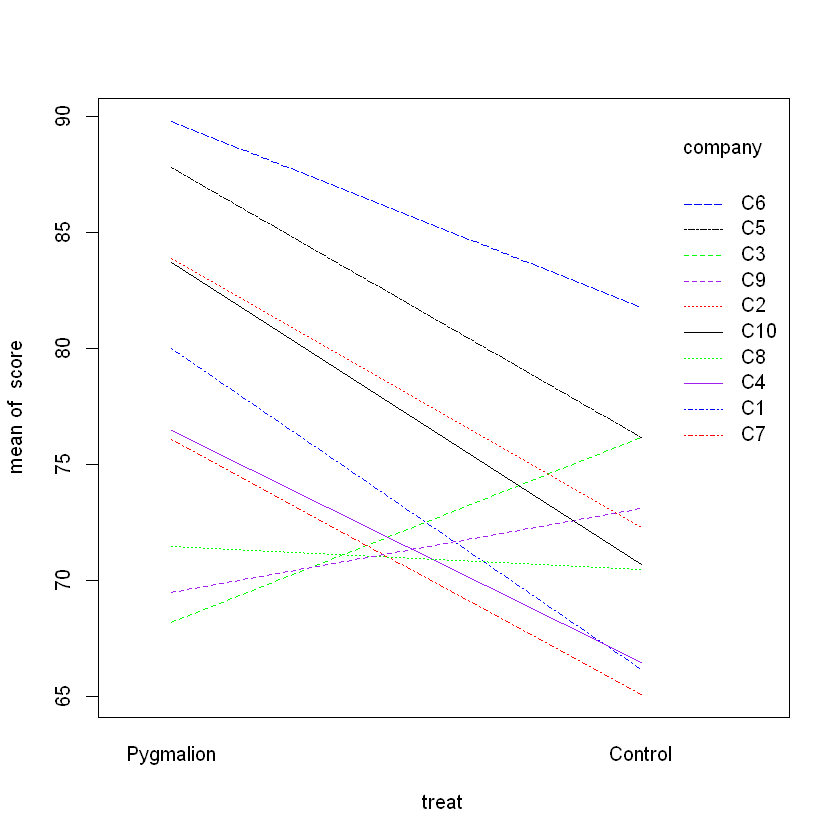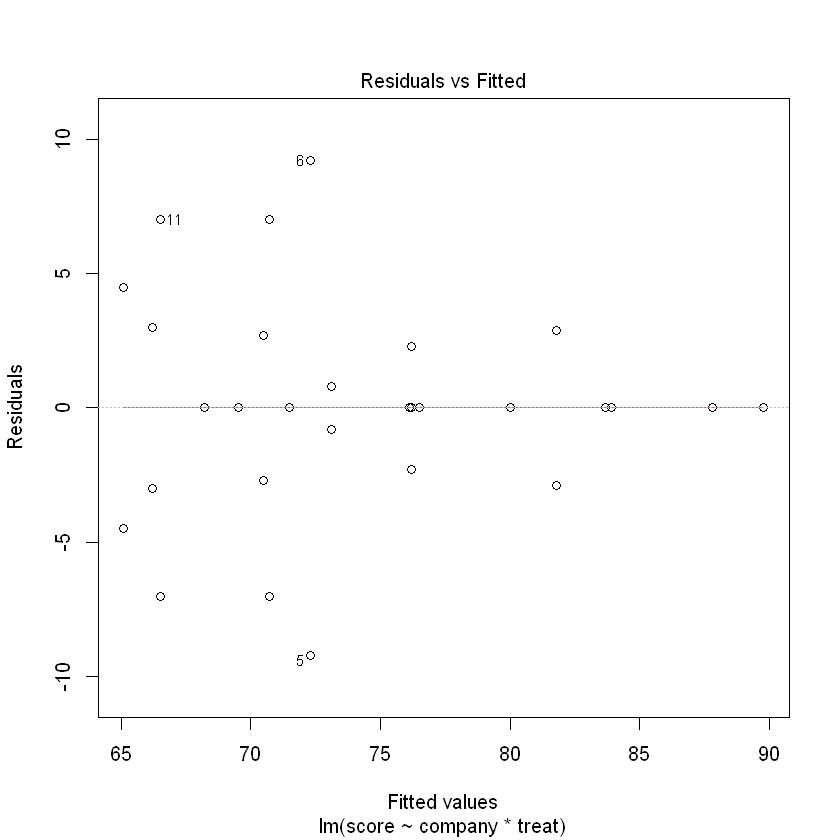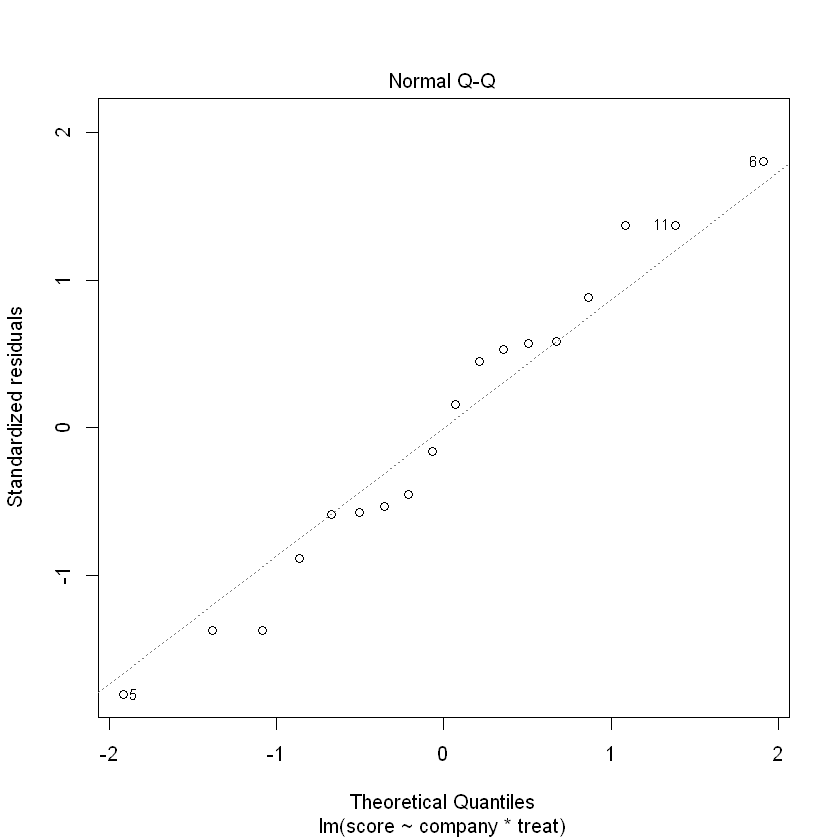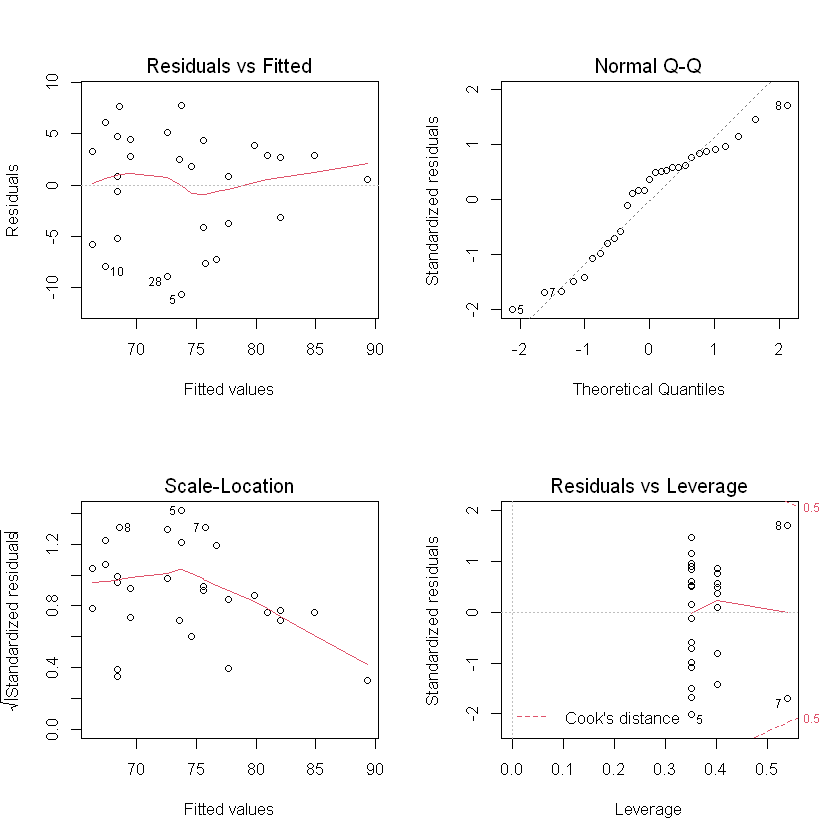Two Way ANOVA
Two Way ANOVA
- Extension of One-way ANOVA, a special case of a GLM.
- Two factors, each with \(\geq 2\) levels.
- Uses a maximum of \((G_1-1) + (G_2 - 1) +(G_1-1)(G_2 - 1)\) (individual + interactions)indicator variables
Two types of factors
- FIXED effect: data has been gathered from all the levels of the factor that are of interest
- Random effect: interest is in all possible levels of factor, but only a random sample of levels is included in the data.
Case Study The Pygmalion Effect
library(Sleuth2)
data = case1302
head(data)
score = data$Score
company = as.factor(data$Company)
treat = as.factor(data$Treat)
| Company | Treat | Score | |
|---|---|---|---|
| <fct> | <fct> | <dbl> | |
| 1 | C1 | Pygmalion | 80.0 |
| 2 | C1 | Control | 63.2 |
| 3 | C1 | Control | 69.2 |
| 4 | C2 | Pygmalion | 83.9 |
| 5 | C2 | Control | 63.1 |
| 6 | C2 | Control | 81.5 |
- Response: score on a test
- Factors:
- Company: 10 levels (C1,...,C10)
- Treatment: 2 levels (Pygmalion, Control)
- Aim: investigate the interaction between Company and Treatment
- Method: Fit a Two-Way ANOVA
Variables
- \(Y_i\) score for \(i\)th platoon
- Explanatory: \(9(\mathbb{I}_{C_m, i})+1(\mathbb{I}_{P_n,i})+9(Interaction)\)
For each indicter: \(\mathbb{I_{C_m,i}}=I\)(ith platoon is from Company m), \(\mathbb{I_{P_n,i}}=I\)(ith platoon is 'Pygmalion')
Overall test and Partial Test
Overall test \(H_0: \beta = \vec{0}\)
Partial test $H_0: $ subset of \(\beta\) are \(0\)
Test statistic:
\[\begin{align*} F &= \frac{(SSReg_{\text{full}} - SSReg_{\text{reduced}}) / d.f._{\text{reduced}}} {MSE_{\text{full}}}\\ &= \frac{(RSS_{\text{full}} - RSS_{\text{reduced}}) / d.f._{\text{reduced}}} {MSE_{\text{full}}} \\ &\sim F_{d.f._{\text{full}}, d.f._{\text{error}}} \end{align*}\]
We can use partial test to see if the interaction terms are needed
Interactive Model
Call:
lm(formula = score ~ company * treat)
Residuals:
Min 1Q Median 3Q Max
-9.2 -2.3 0.0 2.3 9.2
Coefficients:
Estimate Std. Error t value Pr(>|t|)
(Intercept) 80.000 7.204 11.105 1.49e-06 ***
companyC2 3.900 10.188 0.383 0.711
companyC3 -11.800 10.188 -1.158 0.277
companyC4 -3.500 10.188 -0.344 0.739
companyC5 7.800 10.188 0.766 0.463
companyC6 9.800 10.188 0.962 0.361
companyC7 -3.900 10.188 -0.383 0.711
companyC8 -8.500 10.188 -0.834 0.426
companyC9 -10.500 10.188 -1.031 0.330
companyC10 3.700 10.188 0.363 0.725
treatControl -13.800 8.823 -1.564 0.152
companyC2:treatControl 2.200 12.477 0.176 0.864
companyC3:treatControl 21.800 13.477 1.618 0.140
companyC4:treatControl 3.800 12.477 0.305 0.768
companyC5:treatControl 2.200 12.477 0.176 0.864
companyC6:treatControl 5.800 12.477 0.465 0.653
companyC7:treatControl 2.800 12.477 0.224 0.827
companyC8:treatControl 12.800 12.477 1.026 0.332
companyC9:treatControl 17.400 12.477 1.395 0.197
companyC10:treatControl 0.800 12.477 0.064 0.950
---
Signif. codes: 0 '***' 0.001 '**' 0.01 '*' 0.05 '.' 0.1 ' ' 1
Residual standard error: 7.204 on 9 degrees of freedom
Multiple R-squared: 0.7388, Adjusted R-squared: 0.1875
F-statistic: 1.34 on 19 and 9 DF, p-value: 0.3358
| Df | Sum Sq | Mean Sq | F value | Pr(>F) | |
|---|---|---|---|---|---|
| <int> | <dbl> | <dbl> | <dbl> | <dbl> | |
| company | 9 | 670.9755 | 74.55284 | 1.4366558 | 0.29901878 |
| treat | 1 | 338.8828 | 338.88279 | 6.5303739 | 0.03091657 |
| company:treat | 9 | 311.4640 | 34.60711 | 0.6668895 | 0.72211538 |
| Residuals | 9 | 467.0399 | 51.89332 | NA | NA |
Warning message:
"not plotting observations with leverage one:
1, 4, 7, 8, 9, 12, 15, 18, 21, 24, 27"
Additive Model
Call:
lm(formula = score ~ company + treat)
Residuals:
Min 1Q Median 3Q Max
-10.660 -4.147 1.853 3.853 7.740
Coefficients:
Estimate Std. Error t value Pr(>|t|)
(Intercept) 75.61367 4.16822 18.141 5.16e-13 ***
companyC2 5.36667 5.36968 0.999 0.3308
companyC3 0.19658 6.01886 0.033 0.9743
companyC4 -0.96667 5.36968 -0.180 0.8591
companyC5 9.26667 5.36968 1.726 0.1015
companyC6 13.66667 5.36968 2.545 0.0203 *
companyC7 -2.03333 5.36968 -0.379 0.7094
companyC8 0.03333 5.36968 0.006 0.9951
companyC9 1.10000 5.36968 0.205 0.8400
companyC10 4.23333 5.36968 0.788 0.4407
treatControl -7.22051 2.57951 -2.799 0.0119 *
---
Signif. codes: 0 '***' 0.001 '**' 0.01 '*' 0.05 '.' 0.1 ' ' 1
Residual standard error: 6.576 on 18 degrees of freedom
Multiple R-squared: 0.5647, Adjusted R-squared: 0.3228
F-statistic: 2.335 on 10 and 18 DF, p-value: 0.0564
Partial F test (ANOVA)
Test \(H_0:\beta_1 = 0\) (treat Control), \(H_a:\beta_1\neq 1\)
(T-test or partial F test) \(F\sim F_{1, 18}\)
\(p=0.0119\)
Test \(H_0: \beta_2=...=\beta_{10} = 0\), $H_a: $ at least one of \(\beta_2,...,\beta_{10} \neq 0\)
\(F\sim F_{9,18}\)
| Df | Sum Sq | Mean Sq | F value | Pr(>F) | |
|---|---|---|---|---|---|
| <int> | <dbl> | <dbl> | <dbl> | <dbl> | |
| company | 9 | 670.9755 | 74.55284 | 1.723756 | 0.15556403 |
| treat | 1 | 338.8828 | 338.88279 | 7.835401 | 0.01185757 |
| Residuals | 18 | 778.5039 | 43.25022 | NA | NA |
Confidence Interval for two sample t test
\[(\bar{x}_1-\bar{x_2}\pm t\cdot s_p \sqrt{n_1^{-1}+n_2^{-1}} )\]
Least square CI
\[\hat{\beta}_1 \pm t\cdot se(\hat\beta_1)\]
Model Checking
- Model is appropriate (include relevant or exclude irrelevant factors)
- No outliers
- Normality
- Variance assumption may not be satisfied (variance is decreasing), consider weighted least square regression
- Normality satisfied, no dramatic pattern
- No outliers
